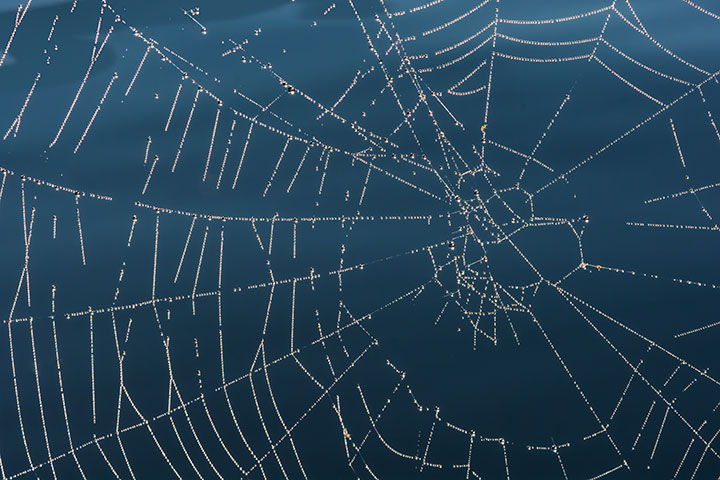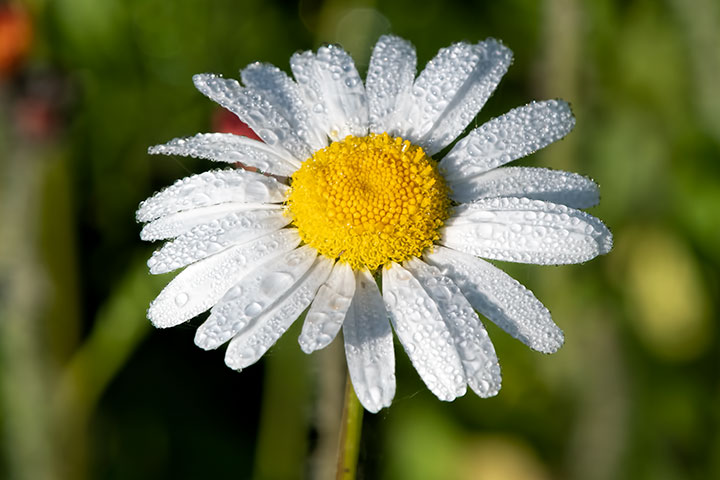
The web of an orb-weaving spider covered in matutinal drops of water is undoubtedly beautiful. But, is the web really covered in dew — as is claimed by a myriad of photo sites? Alas, this is something for which reason is unlikely to overcome glibness. After all, what could be more obvious: of course those droplets are dew — right?
Dew is not a generic name for water drops that appear early in the day. Actually, a number of processes can cause such drops: along with dew are drizzle, rain, guttation, and the collection of fog drops.
Dew results from temperature differences that increase with object size
When an object has a temperature lower than the dew-point temperature of the surrounding air, dew will form on it. A net loss of infrared radiation to the sky will drop an object’s temperature, but thermal conduction from the surrounding warmer air will counteract this. For a tiny object (a spider’s thread), conduction keeps the object at the same temperature as the air, and dew won’t form. For a larger object (a flower) the radiation loss will probably win, and dew will form.
Collection of fog drops is greatest with tiny objects
Yet, droplets sometimes appear on a spider’s web. As they don’t result from dew, how do they form? This is a question of how air flows around and past objects. A small object (spider’s thread) does not deviate airflow significantly, so drifting fog droplets just collide with, and are collected by, the object. A larger object (daisy) causes the air to flow around it, and this carries fog droplets around and past it, so their intersection is minimal.
Dew has formed on the sky-facing petals of this daisy. Net infrared radiation loss caused the petals to cool and dew to form. The flower is large enough to be able to sustain a temperature difference between itself and the surrounding air, so dew can form. (The daisy’s stem was protected by the flower from such radiation losses to the sky and so shows no dew.)

It is tempting to think that the same process of dew formation would have caused the formation of droplets on the spider’s web. Yet, the spider threads are so fine that thermal conduction guarantees that they will have the same temperature as the air. So, dew cannot form here. Yet, the tiny threads of the web intersect some of the drops of a steam fog drifting past. (A larger object would merely cause the airflow to be deviated and the drops to flow around them.) The result is that small objects (such as spider threads) intersect passing fog drops, but haven’t sustained the temperature difference that results in dew. Larger objects (such as the daisy) have a dew-producing temperature difference, but don’t intersect fog drops.

Once, while mentioning this behavioural difference during a presentation, I was asked why the drops on the spider’s web were often uniform in size and spacing (as shown in this older picture), despite having resulted from random impacts of fog droplets. I didn’t know the answer. But it turns out that it has to do with regularly spaced sticky balls of glue the spider attaches to the spiral threads so as to trap flying insects. These glue drops absorb the collected water drops and swell producing the both the regularity and the difference between the drops on the spiral and radial threads.


Fascinating study. I learned something today. Thank you. Beautiful picture of an art form
Nice illustrative photos and as always, great information. Thank you!
You inform us again, Alistair, with your amazing wealth of knowledge about even such minute matters of water droplets, dew, sticky balls of spider glue…and all the rest. Thanks!!! I’m very grateful for patient, scientific observers such as you!
Fascinating and beautiful, as usual. Thank you.
The New York Times Science has a video about ground spiders that can “fly” over oceans on a single web string. Wonders of nature.
Thanks so much that was fascinating .
Maybe something of the same process in involved in Scotland’s soft rainfall, or smirr which is almost invisible yet , imposes a soaking on those lucky enough to be caught in it ?
“The result is that small objects (such as spider threads) intersect passing fog drops, but haven’t sustained the temperature difference that results in dew. Larger objects (such as the daisy) have a dew-producing temperature difference, but don’t intersect fog drops.”
This will stick in my memory like beaded droplets of spider glue.
Thanks much!
Trevor